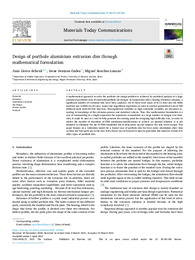Por favor, use este identificador para citar o enlazar este ítem:
https://hdl.handle.net/11000/33435
Design of porthole aluminium extrusion dies through mathematical formulation
Título :
Design of porthole aluminium extrusion dies through mathematical formulation |
Autor :
Llorca-Schenk, Juan 
Sentana-Gadea, Irene
Sánchez-Lozano, Miguel |
Editor :
Elsevier |
Departamento:
Departamentos de la UMH::Ingeniería Mecánica y Energía |
Fecha de publicación:
2021-06 |
URI :
https://hdl.handle.net/11000/33435 |
Resumen :
A mathematical approach to solve the porthole die design problem is achieved by statistical analysis of a large
amount of geometric data of successful porthole die designs. In cooperation with a leading extrusion company, a
significant number of extrusion dies have been analysed. All of them were made of H-13 steel and the billet
material was Al-6063 in all cases. Linear and logarithmic regression are used to analyse geometrical data of 596
different ports from 88 first trial dies. Non-significant variables or high correlated variables are discarded according to knowledge of the extrusion process and statistical criteria. Thus, this mathematical formulation is a
way of summarizing in a single expression the experience accumulated in a large number of designs over time.
Also, it could be used as a tool to help generate the starting point for designing high difficulty dies, in order to
reduce the number of iterations of FEM simulation/modifications to achieve an optimal solution. It is not
intended to eliminate the use of FEM simulation but to help speed up and improve the task of die design. This
paper focuses on a validation model for a typical case of porthole dies for 6xxx series aluminium alloy: four
cavities and four ports per cavity dies. But a broad way of research is open to generalise this model or extend it to
other types of porthole dies.
|
Palabras clave/Materias:
Extrusion
Aluminium extrusion
Die design
Hollow profile
Porthole |
Área de conocimiento :
CDU: Ciencias aplicadas: Ingeniería. Tecnología |
Tipo de documento :
info:eu-repo/semantics/article |
Derechos de acceso:
info:eu-repo/semantics/openAccess
Attribution-NonCommercial-NoDerivatives 4.0 Internacional |
DOI :
https://doi.org/10.1016/j.mtcomm.2021.102301 |
Publicado en:
Materials Today Communications,Volume 27, June 2021 |
Aparece en las colecciones:
Artículos Ingeniería Mecánica y Energía
|
 La licencia se describe como: Atribución-NonComercial-NoDerivada 4.0 Internacional.
La licencia se describe como: Atribución-NonComercial-NoDerivada 4.0 Internacional.
 La licencia se describe como: Atribución-NonComercial-NoDerivada 4.0 Internacional.
La licencia se describe como: Atribución-NonComercial-NoDerivada 4.0 Internacional.
.png)
